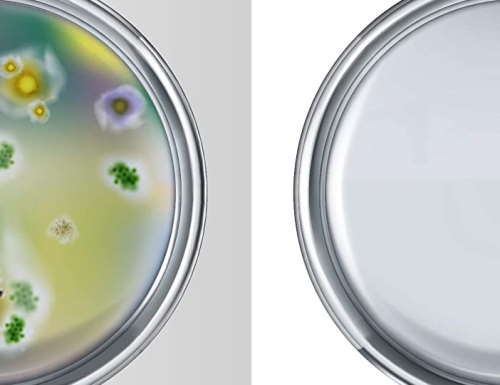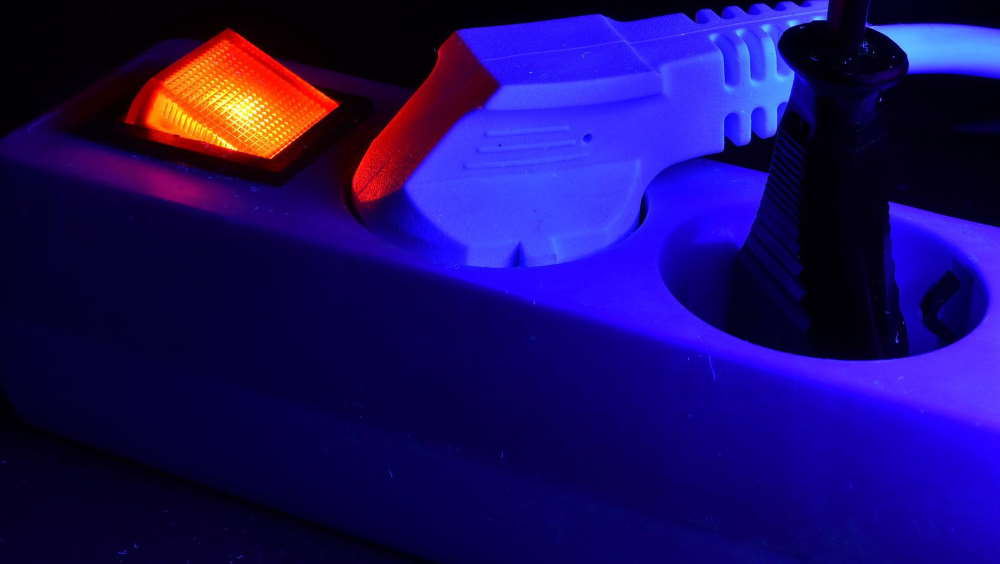Find out how UV light actually kills mold and spores, and what spectrum helps to remove mold and viruses. This information will help you to remove microorganisms that compromise health.
The ultraviolet energy is farthest from visible light, shorter than rays in sunlight, and is primarily noted for its ability to fluoresce minerals for chemical analysis, and for its germicidal effects. A shortwave ultraviolet light in the range of 280 to 100 nm can help kill mold and prevent its growth.
People who live in a warm and humid climate often deal with the spread of mold and other microorganisms. Throw severe storms or frequent drizzles into the mix, and you may get accelerated growth of mold in your home, due to consistent humidity or leaks. According to HomeAdvisor.com, the average nationwide cost of mold removal is around $2,250, which may soar higher if you have a larger house or the mold growth situation is severe.
Does UV light kill mold?
Yes, UV light can kill mold. UV light has been proven to be effective in killing mold spores and other pollutants in the air. In addition, UV light can be used to disinfect surfaces, making it an ideal choice for killing mold in your home.
In this video, you can see how UV light can destroy mold and other microorganisms, and also how harmful it can be to the human body. Watch the video and learn how it works, if it can kill viruses, if it produces ozone and whether or not that’s all a good idea.
Among different mold remediation methods, UV (ultraviolet) is probably the most effective, because it immediately disinfects any surface. Just like visible light, UV light is also a segment of electromagnetic radiation, with wavelengths between 10nm and 400nm. About 10 percent of solar radiation is UV light and it can be replicated with devices used for different purposes. According to homeinspectorsecrets.com, UV wavelengths between 100nm and 280nm have germicidal properties, but 250nm is the most widely used to disinfect air or surface. Because UV light directly alters the molecular structures of microorganisms, it doesn’t leave any toxic substances, unlike commercial mold removal products. UV light is very effective, because it attacks small organisms, although they are resistant to antibiotics or toxic substances. No mold, bacteria, or viruses can prevent UV light from altering molecular structures in their nucleus.
What is the best mold-killing light?
For killing mold, the best light is UV light. UV light has been proven to be effective in killing mold spores and other pollutants in the air. In addition, UV light can be used to disinfect surfaces, making it an ideal choice for killing mold in your home.
What is the best UV light for mold?
The best UV light for killing mold is a UV-C light. UV-C light is the most effective wavelength of UV light for killing mold, bacteria, and viruses. UV-C light is also the most affordable option for killing mold in the home.
What type of UV light kills mold?
UV-C light is the most effective type of UV light for killing mold. UV-C light has a wavelength of 100 to 280 nanometers, which is the most effective range for killing mold spores and other pollutants.
UV Light Kills Mold And Spores That Can Hurt Your Health
Arthur Downes and Thomas P. Blunt proposed the use of short-wavelength light to sterilize surfaces in 1878 and it had been known at the time that UV light shows germicidal properties. Later, Niels Finsen was awarded Nobel Prize for Medicine in 1903 for treating lupus vulgaris on patients’ skin with UV light due to the spread of Mycobacterium tuberculosis. Today, UV light is used for different purposes, including eradicating mold and its spores. UV wavelengths between 200nm and 300nm are absorbed most effectively by nucleic acids, which prevent the production of certain proteins in cell nuclei. This results in the inactivation or death of small organisms.

The effectiveness of UV light for eradicating mold and its spores depends on the exposure duration, wavelength, and intensity of radiation. Depending on the extent of the mold growth, it could be necessary to repeatedly expose a surface with UV light. Mold cells have the ability to repair DNA damaged by UV, so it’s important to adjust light intensity, wavelengths, duration, and exposure frequently accordingly.
UV light triggers a reaction among thymine (T) molecules, one of four nucleotide bases needed to build DNA, along with adenine (A), cytosine (C), and guanine (G). The UV-induced reactions produce highly stable or non-reactive thymine dimers. The internal nuclear mechanism responds to the increased presence of thymine dimers by removing them and using new nucleotides to fill in the gaps. However, the damage to the DNA chain will become too extensive if there are too many thymine dimers. DNA breakdown will prevent mold and its spores from carrying out their normal functions. A gene product, known as p53, initiates the repair mechanism whenever DNA gets damaged by external factors. However, p53 will trigger programmed cell death or apoptosis instead, if the damage is too severe.
UV light is highly effective at eradicating mold and reversing its growth by killing airborne spores. When set at 250nm wavelength, UV light easily penetrates mold and causes damage to nucleic acid production. At certain intensity and duration, mold cells will begin to die off in just two hours. In fact, UV light may kill off 99.99 percent of the mold, if the removal process is performed correctly. Be sure to choose operators who have the skills and experience to eradicate mold growth with proper UV exposure. It is also important to immediately resolve water leakage problems, because extra humidity may cause mold to re-emerge very quickly.
UV light that kills mold
Ultraviolet (UV) light is a proven method of killing mold. UV light can be used to clean the air, surfaces, and materials in an area. The light destroys the DNA of the mold, preventing it from growing and spreading.
What is UV light frequency?
Ultraviolet (UV) light has wavelengths ranging from 10 nm to 400 nm, corresponding to frequencies ranging from 30 PHz to 750 THz.
Be Aware That UV Light Can Cause Cancer
It is important to know the risk of using UV light to kill mold and other microorganisms. If you’re exposed to UV light there is a risk of cancer. Just like sunlight exposure, UV lamps produce light that can cause cancer. That is why you should use them only when you’re out of reach. Skin sensitivity, eyes, etc… All this means you should only use a UV lamps when the room is empty.
Mold remediation operators choose 200nm to 300nm UV wavelengths, but they may potentially cause health problems. UV radiation with wavelengths higher than 180nm has an increased ability to alter cells at molecular levels. Short-term exposure to high-intensity UV light may cause sunburn and elevate the risks of skin cancers. People with lighter skin or lower amounts of melanin are more vulnerable to skin problems when exposed to UV radiation. UV exposure may also cause damage to the conjunctiva or cornea, which results in light sensitivity. Short-term symptoms of UV exposure may last for 30 minutes to 24 hours. However, prolonged exposure may result in significant visual impairment or even blindness due to permanent retinal damage.
There are ways to limit the risks of excessive UV exposure when remediating mold growth. If the presence of mold is limited to the specific area of the wall, you may use enclosures to prevent unwanted radiation. You may use screens to absorb, block or reflect UV light. When using a UV lamp, make sure that it is orientated toward the moldy surface to limit exposure to the operator. Any shiny or reflective objects should be removed from the area, because they may accidentally cause eye damage. Some UV sources generate ozone gas and it is highly recommended to ensure adequate ventilation, especially during prolonged use of UV-C sources.
A trained operator knows how to minimize exposure while ensuring the maximum effectiveness of UV mold remediation. Family members and pets should be in another room or outside the house. In offices or public spaces, it is a requirement to use hazard warning signs to prevent accidental exposures to employees and passers-by. The UV illuminator should have multiple warning lights to indicate whether it is turned on or being energized. Because UV light is invisible, warning lights are necessary to prevent accidental emissions.
Areas of the body susceptible to UV exposure are the face, eyes, and hands. It is a good practice for operators’ hands to get protected by latex or nitrile gloves. They should wear long-sleeve coats and be sure there’s no gap between the glove and cuff. Operators should wear full-face visors coated with a material that absorbs UV light. Any eyeglass, goggle, or visor should conform to EN 170:2002 European standards that regulate eye protection. UV-C lights should be placed strategically inside the basement or any place in your home with mold growth. Before UV-C lights are turned on, doors and curtains should be closed. Operators determine the ideal duration, depending on the light intensity and severity of mold growth.
Q and A
UV light penetrates directly into the mold cells and damages the nucleic acids. The mold cells eventually die off after a period of an hour or two.
Ultraviolet light kills mold in the air and on surfaces. It kills mold and airborne spores also.
Ultraviolet light kills mold, fungus, bacteria, and viruses. Remember, people are affected in case of exposure.
The answer is Yes. UV light kills mold wherever it reaches.

With these germicidal lamps, a special UV light type prevents contamination in your home, garage and wherever is necessary.
They emit 254 nm UV light that is efficient in destroying bacteria, molds, yeast, and viruses. Depending on a UV light bulb model, a life span is approximately 2000-4000 hours.
Conclusion
UV mold remediation is effective to prevent or alleviate symptoms caused by mold growth in your house. If family members have acute symptoms of respiratory systems, they could be caused by mold growth, especially if medications have no or little effects. UV light also has a positive side effect on indoor air quality. Thorough UV-C exposure will eradicate mold growth on surfaces and kill airborne pathogens. Stubborn drug-resistant bacteria are unable to withstand prolonged UV exposure. UV-C light easily penetrates mold cells and alters the molecular structures of their nucleus. When enough thymine dimers are present, mold cells will be rendered inactive or killed completely.

Ultraviolet (UV) light is effective against bacteria as it can disrupt their DNA and prevent them from reproducing. This light is used in hospitals and other medical facilities to prevent bacterial and viral infections from spreading. UV light can also clean surfaces and water and is often used in water purification systems.
Despite its effectiveness and versatility, UV light can pose health risks. If it can alter and kill mold cells, it can do the same to cells of your body. Slight redness, pain, and sunburn are short-term symptoms of UV exposure, but they may also cause premature aging and skin cancer. Before UV-C illuminators are turned on in an enclosed part of your home, everyone should leave, including the operator. In some cases, handheld UV-C sources are needed to reach tight spots, like areas under the sink or cabinet. In this case, the operator should wear PPE with coat and latex gloves to block UV-C light. Although operators already wear a full-face visor, they should also wear safety goggles to further minimize the risk of eye damage.
